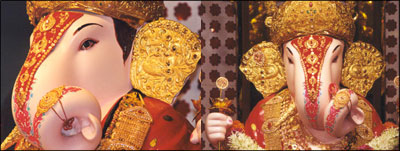 |
| Ganesh Chaturthi |
 |
 |
Ganesh Chaturthi Lord Ganesh, the patron deity of
Maharashtra, is the God of wisdom. Come August, preparations to celebrate
Ganesh Chaturthi - the auspicious day when Lord Ganesh was born - begin with
great enthusiasm all over the state. Ganesh is the elephant headed son of Shiva
and Parvathi. Ganesh is believed to be the harbinger of good luck who removes
all obstacles to success. He brings prosperity and keeps natural calamities at
bay in the lives of those who worship him. This ten-day festival begins with
the installation of the deity, who is then worshipped daily till the immersion
on the final day. Small Ganesh idols are installed in homes. Idols can tower
10m high and weigh several tones. On the tenth day, serpentine processions fill
the streets and with the accompaniment of drumbeats and music the image of
Ganesh is immersed in the water. Devotees chant 'Ganapati Bappa Morya' which
means Ganesh, Daddy, please come back soon next year.
The Visarjan (immersion) Processions and Ceremony
The festival ends with the ceremony of immersion of the idols in the sea or
rivers and wells.
This ceremony which is called Ganesha-Visarjan which means immersion of Ganesha
is as popular as the festival proper. During the immersion ceremony huge crowds
move in a procession carrying idols of Ganesha towards the places of immersion.
These processions which take place with great fanfare, begins in the afternoon
and continue till the late hours of the night.
Although this festival is observed in all parts of the country, it is
celebrated with maximum fervour in Maharashtra where it is celebrated both
publicly and privately. Apart from the small idols of Ganesha that are
installed in various houses, there are also many public celebrations called
Sarvajanik Ganeshotsava. The Public Celebrations of Ganesh-Chaturthi - Started
by Lokmanya Tilak
In these public celebrations huge images of Ganesha ranging from 10 feet to
40 feet are installed and alongwith the daily prayers and hymns, there are
entertainment programmes which are a major attraction. Till the turn of the
last century, this festival was celebrated only in homes and temples. But
during the struggle for independence against British rule, Lokmanya Tilak (an
important freedom fighter who led the Indian freedom struggle before Mahatma
Gandhi took over) gave it the form of a public festival. Tilak did this so as
to cleverly broadcast his political message of freedom for India.
Carried out in the garb of a religious activity, it was difficult for the
British Administration to curb it. But the festival once having acquired a
public form for a political purpose, retained that form even after the
political purpose did not exist. Hence even today in independent India
Ganeshotsava is celebrated both publicly and privately.
|
|
|
|